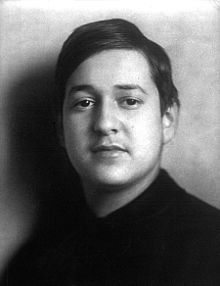Symphony in F sharp (Korngold)
The symphony in F sharp op. 40 by the Austrian-American composer Erich Wolfgang Korngold (1897–1957) was completed in 1952 and premiered in 1954.
Emergence
Korngold made plans to compose a symphony in 1947. Concrete parts were made from 1949 onwards on his first, overall disappointing trip to Europe after the Second World War . Korngold had established himself as a film composer in California and had been a US citizen since 1943. In Europe, however, Korngold's early successes (such as Die tote Stadt ) were now almost forgotten, also as a result of the National Socialist performance bans on Jewish composers; his compositional style was also considered to be out of date in view of new trends after the Second World War.
In November 1949 he informed his mother by letter from Vienna that the first movement had been sketched, the scherzo and the slow movement had already been completed in his head. At the end, however, he did not bring his Symphony in F sharp op. 40 until December 1952, and has since returned to the USA. It remained the composer's only one (there are drafts for a 2nd symphony, which Korngold, who died in 1957, could no longer execute). The work is dedicated to the memory of US President Franklin Delano Roosevelt , who died in 1945 .
Cast and duration of performance
The score calls for a large orchestra with extended percussion: 3 flutes (also piccolo ), 2 oboes , 2 clarinets , bass clarinet , 2 bassoons , 4 horns , 3 trumpets , 4 trombones , tuba , timpani , percussion (3 players) with bass drum , Cymbals , gong , glockenspiel , xylophone and marimba , harp , piano , celesta and strings (16 first and 14 second violins , 10 violas , 10 cellos and 8 double basses are required ).
The performance of the symphony is around 50 minutes.
Characterization and structure
The key of F sharp is rarely used for symphonic works; A well-known example is the unfinished 10th Symphony of Gustav Mahler , whose work can also be found in Korngold's symphony. The key in Korngold's symphony oscillates permanently between major and minor and is only led to the triumphant F sharp major at the end. The symphony is in 4 movements, with the Scherzo in second place:
1. Moderato ma energico
At the beginning there are the rough, syncopated beats of the orchestra, followed by a complex main theme in the clarinet. The further development is characterized by partly dissonant courses. The lyrical secondary theme based on fourths and fifths (typical for Korngold) and individual more optimistic passages cannot significantly brighten up the overall gloomy, tragic movement, which fades away softly.
2. Scherzo: Allegro molto - Trio: Molto meno (Tranquillo)
An advancing, tarantella-like , brilliantly orchestrated A section frames a trio that recurs twice and is characterized by a mysterious, chromatically descending theme.
3. Adagio: Lento
The slowest and at the same time longest movement of the symphony has the character of a funeral march and at times reminds of Anton Bruckner . Korngold uses elements from earlier film scores in a modified form: the main theme is based on a motif from a queen's favorite , the second theme on the main title of Unter Piratenflagge , the implementation draws on the leitmotif of A restless life .
4th finale: Allegro gaio
The final movement, in the form of a rondo , draws kaleidoscopically on themes from the previous movements. In an optimistic attitude, the coda of the first movement is taken up at the end , but leads to a triumphant ending.
World premiere and reception history
The first performance took place in the context of a radio broadcast on October 17, 1954 in the large broadcasting hall of the Vienna Broadcasting Corporation. Harold Byrns directed the Vienna Symphony Orchestra . Korngold was not impressed by the conductor's performance, although the audience and the press received the work positively overall. Nevertheless, there were only two more performances during the composer's lifetime ( Munich Philharmonic under the direction of Jan Koetsier and the Grazer Philharmonic Orchestra under the direction of Alois Melichar , both in 1955). Bruno Walter certified the symphony in 1955 as " an important work with an original thematic substance, of rare emotional power and a masterly symphonic form ", but could no longer take on a performance due to its age.
It was not until 1972 that Rudolf Kempe brought the work to a new performance with the Munich Philharmonic and also recorded it on record. In 1988 a recording with Werner Andreas Albert followed . In the meantime there are a few more recordings, for example under the direction of Franz Welser-Möst , André Previn and Marc Albrecht .
Individual evidence
- ↑ Brendan G. Carroll: The Last Prodigy , 1997, pp. 357f., Cit. n. Guy Wagner: Korngold. Music is music . Matthes & Seitz Berlin, 2007, p. 429
literature
- Guy Wagner: Korngold. Music is music. Matthes & Seitz Berlin, 2007, pp. 390-429
